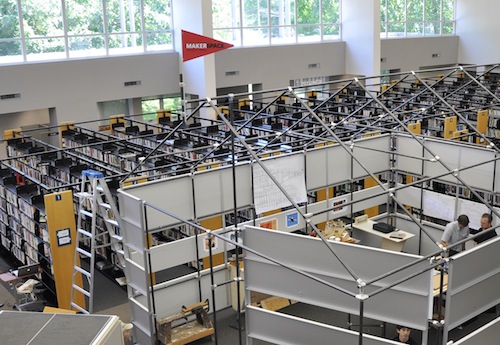It’s an interesting time for libraries. With the widespread availability of e-books and the mountains of reference materials available online, libraries are taking a critical look at their offerings and looking for ways to evolve with the times. For some library systems that means expanding their materials list to include non-traditional items including tools, cake pans and art. For others, that means increasing their in-house offerings of workshops, events and community gatherings.
For the Westport, Conn. library, the next step in its evolution was the creation of a maker space, open to all library patrons, located in the middle of the library. Encouraged by the success of a mini maker faire which attracted over 2,000 participants, library staff put into action a plan to embed a maker space in the library. Currently featuring maker-in-residence Joseph Schott, the space has big plans for desktop fabrication, open source hardware projects and whatever other ideas local makers may want to pursue.
Located among the stacks of books, the maker space, which is in its first month, is already home to an ambitious 3-D printing project. Along with library patrons, Schott is designing, fabricating and building two airplanes that will be displayed in the library above the maker space. Using the 3-D printer to fabricate the materials needed for the airplanes, makers are also using the space to fabricate some of the tools being used in the space. One patron recently printed a wrench.
The project is a way for the library to spread the word about the new maker space, introduce patrons to the space and the tools, demonstrate the creative, do-it-yourself ethos of the maker movement and generate enthusiasm among current and future makers.
Expanding on the notion that libraries are places to borrow books and media materials, library maker spaces can build community, encourage innovation and prompt a return to the vision of libraries as unrestricted hubs of information; with the information flowing both ways. The taking in of information is no longer enough; we must be able to then do something with that information, and here is where maker spaces shine. They allow, on a peer-to-peer scale, people to bring information and ideas to life. As Schott says in the video below, “The idea that we can be creative and do things for ourselves and continue the history of American ingenuity is great for this community and a good reason for the library to do what it’s doing.”









